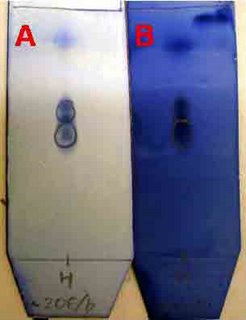
Don't you just love that feeling when you are checking your reaction mixture by TLC and no matter which stain you use nothing appears on the plate. If your compound also isn't UV active you've got a real problem. Well the good news is that there is one stain that will do the job for you -
Hanessian's Stain!
Hanessian's stain is an excellent
multi-purpose stain that when used the right way usually gives blue spots (TLC plate A). Since it is a water based stain it requires vigorous heating for development. However, if you overdo it the entire plate goes dark blue (TLC plate B).
Hanessian's Stain Recipe 1
100 ml container
90 ml Water
5 g Ammonium molybdate, (NH4)6Mo7O24-4H20
1 g Cerium sulfate, Ce(SO4)2
10 ml Concentrated sulfuric acid
-
Hanessian's Stain Recipe 2
100 ml container
90 ml Water
2.5 g Ammonium molybdate, (NH4)6Mo7O24-4H20
1 g Cerium ammonium sulfate, Ce(NH4)4(SO4)4-2H2O
10 ml Concentrated sulfuric acid
-
Dissolve ammonium molybdate and cerium sulfate in water (with heating if required) followed by careful addition of concentrated sulfuric acid. Sometimes an insoluble residue is observed. If that happens remove it by filtration. Cerium sulfate can be replaced with Cerium ammonium sulfate which is significantly cheaper (Recipe 2). Hanessian's stain is used just as previously described for the Vanillin Stain although it requires more vigorous heating. Because rather harsh heating is required this stain may prove inefficient with volatile compounds. Also keep in mind that this a very sensitive stain so even trace impurities can appear as significant spots on your TLC plate. D!



 After treatment with a heat gun Ninhydrin Stain tends to give brightly coloured pink to purple spots as shown above. The spots can fade rather fast so record the result immediately. In the past I have been using a Ninhydrin Stain that didn't contain water, however adding a bit of water seems to improve the result a fair bit. D!
After treatment with a heat gun Ninhydrin Stain tends to give brightly coloured pink to purple spots as shown above. The spots can fade rather fast so record the result immediately. In the past I have been using a Ninhydrin Stain that didn't contain water, however adding a bit of water seems to improve the result a fair bit. D!







 orcid.org/0000-0003-3926-7047
orcid.org/0000-0003-3926-7047


